We have a strict honest review policy, but please note that when you buy through our links, we may receive a commission. This is at no extra cost to you.
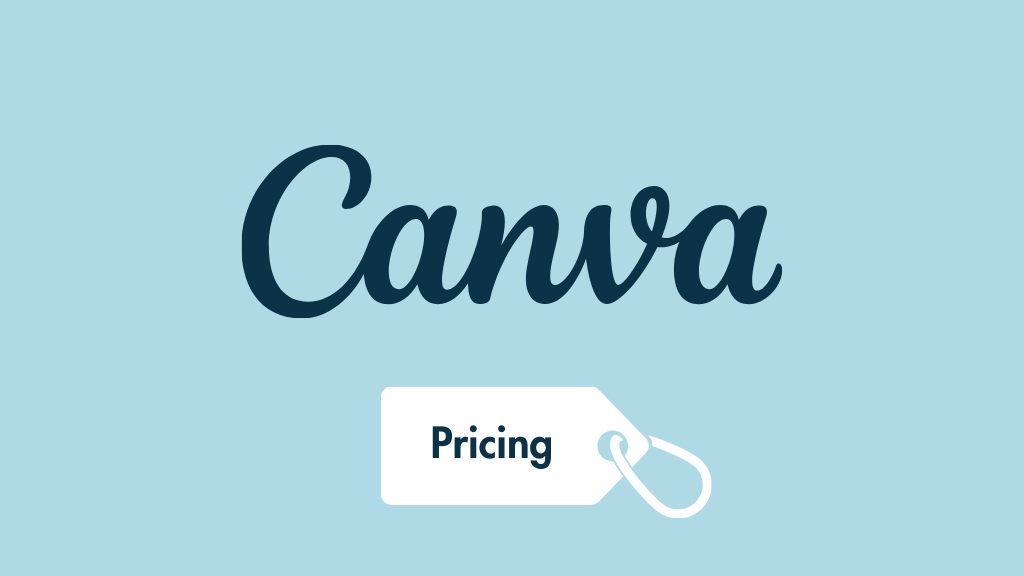
In this in-depth look at Canva pricing, I take you through all the Canva plans available and help you work out which is the best one for your needs.
Which Canva plan is best for you? The quick answer…
If you don’t have any budget at all, or you’re curious about what Canva can do, try ‘Canva Free.’
If you work alone and want to access all the key Canva features, or need a very cheap source of royalty-free images and videos, try ‘Canva Pro.’ This costs $15 per month, but is available as a free 30-day trial via the link below.
If you need to provide your team members with access to Canva, and require advanced workflow management, and tighter controls over branding, try ‘Canva Business.’ This costs $20 per seat.
If you’re running a large organization and need enterprise-grade features (advanced security, SSO, custom integrations, and priority support), try Canva Enterprise. Pricing for this plan is negotiable.
I’ll start this pricing comparison off with a look at Canva’s free plan.
Canva Free — $0 per month
As the name suggests, this plan is entirely free — but it’s surprisingly good! It’s perfectly possible to use a free Canva account to create designs that are professional in appearance and look great both online and printed.
Key features of the free Canva plan
The free plan gives you access to the following key features:
- 1.6+ million free templates
- Over 100 design layouts (social media posts, presentations, letters etc.)
- Over 4.7 million free photos and graphics
- The ability to work on your designs with others at the same time
- 5GB cloud storage
- limited access to some Canva AI features
- The option to save your work in an unlimited number of folders
- The option to export your work into various file formats.
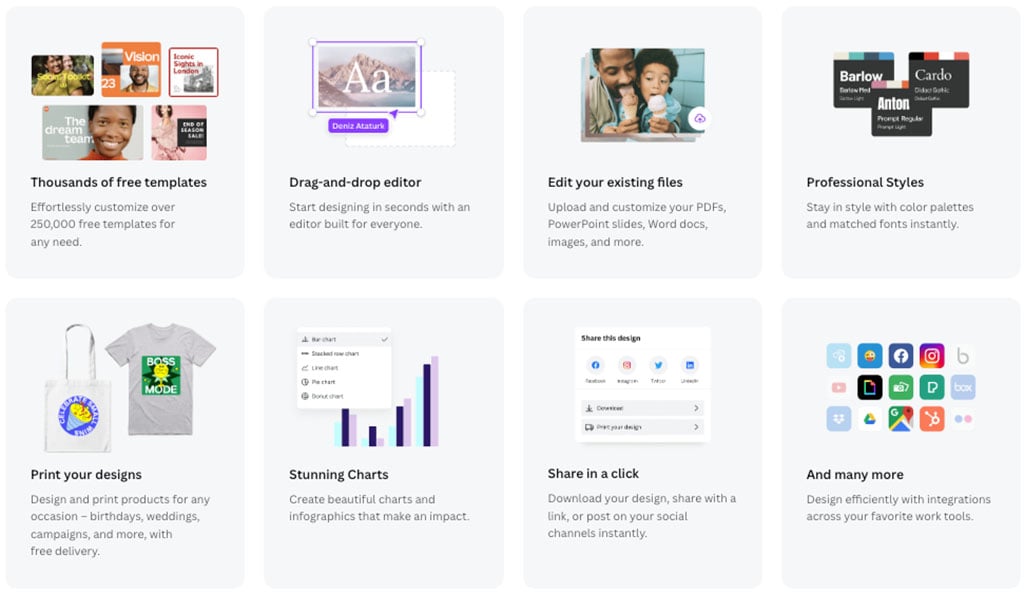
Using these features, you can do some pretty decent design work – if you’re starting a new business and have no budget to invest in design, the Canva free plan can empower you to create some very professional-looking visual assets without any monthly fees to worry about.
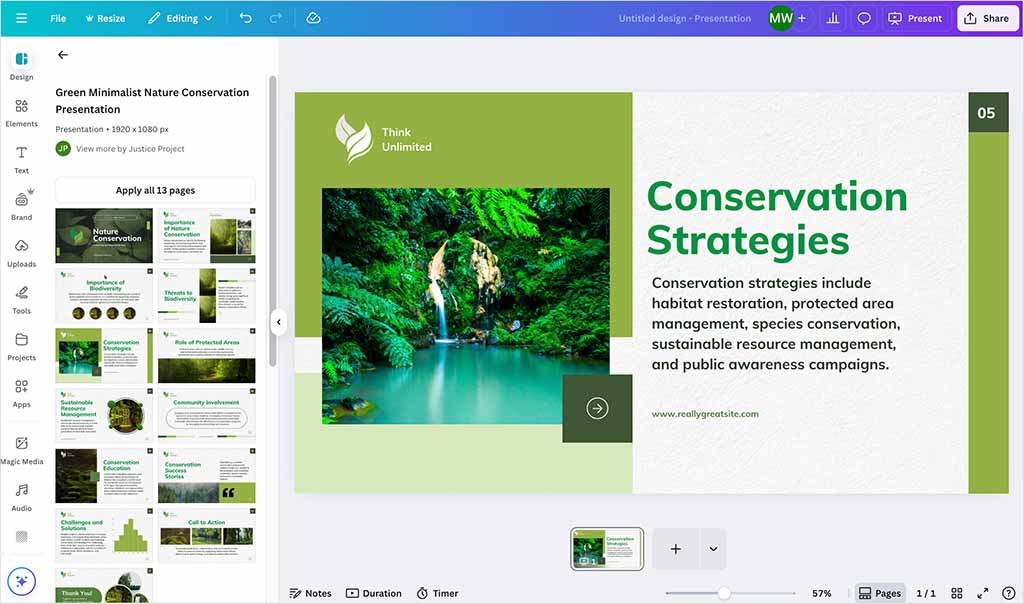
You can learn more about all the features included in the free plan here.
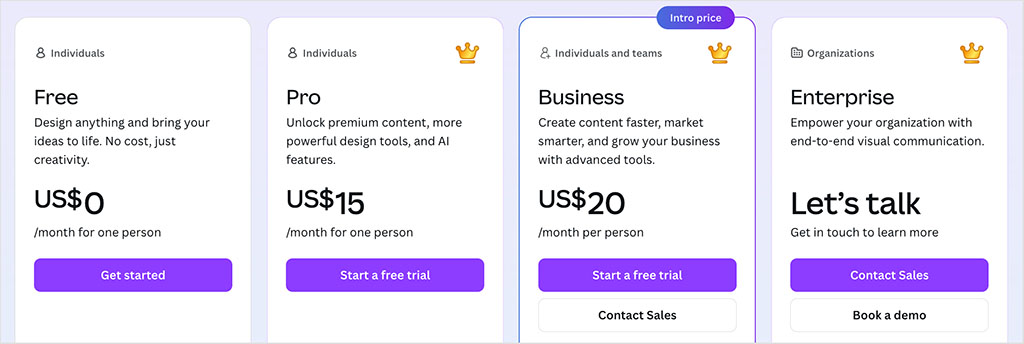
However, as your business operations expand, you may find yourself outgrowing the capabilities of ‘Canva Free’, and exploring one of its premium plans.
Let’s take a look at those, starting with ‘Canva Pro.’
Canva Free vs Pro video comparison
Canva Pro — $15 per month or $120 per year
‘Canva Pro’ can be paid for in two ways: either on a monthly basis or an annual one.
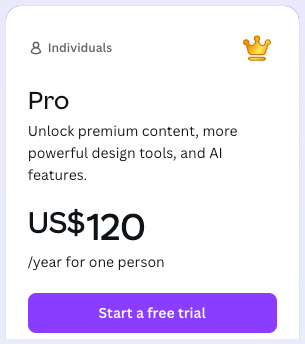
Paying monthly involves a $15 per month fee; doing so annually costs $120 per year (saving you around $60 in total over a 12-month period).
Try every feature of Canva Pro for free – for 30 days
Canva is currently making a 30-day free trial of Canva Pro available to Style Factory readers. This special trial gives you full access to all the Canva Pro features and assets for several weeks, and lets you export all your designs too.
(You can learn more about the Canva free trial features here).
But what do you get for this extra fee that’s not available from the Canva free plan?
Below you’ll find a list of the key features that I think it’s worth upgrading to the ‘Canva Pro’ plan for (in order of significance).
Premium stock photos, videos and graphics
While you can get by on the free version of Canva, and create some very professional visuals with it, the plan limits you to a more basic library of stock images and graphics.
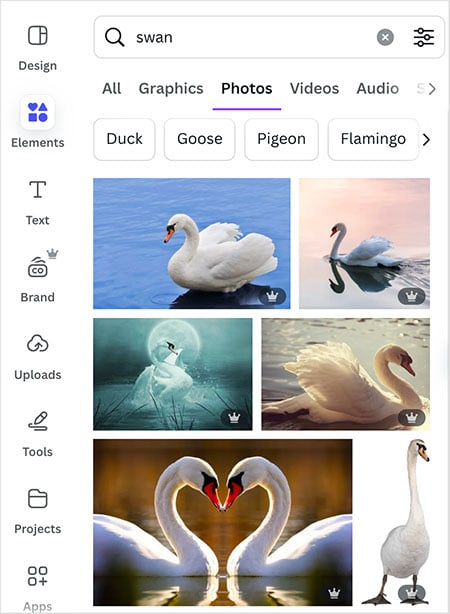
With ‘Canva Pro,’ you get an enormous range of additional royalty-free multimedia assets — 141+ million in total. These include graphics, icons, photos, videos and audio (music and sound effects).
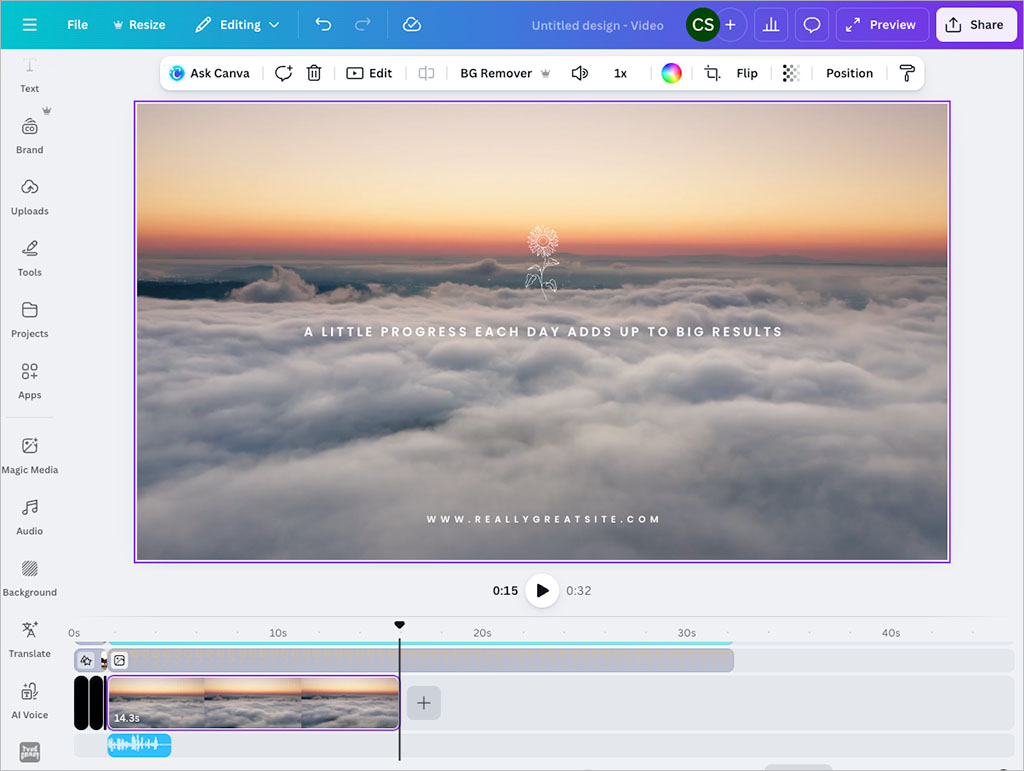
This library opens up the creative possibilities significantly — and when you consider how much some stock photo sites charge for just one image, it represents really good value for money.
Even if you only ever used Canva to source stock photos and videos, and didn’t bother with any of its design tools, you’d be getting an awful lot of bang for your buck.
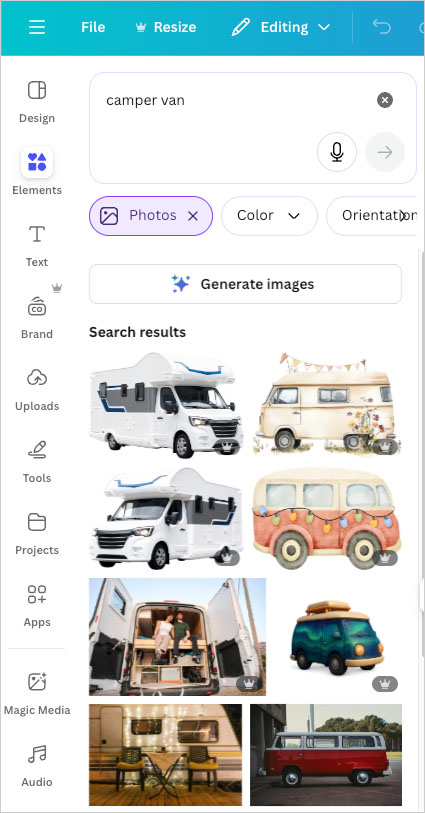
More templates
Although the ‘Canva Free’ plan is pretty generous when it comes to templates, giving you access to 1.6+ million, you get a lot more of them on the ‘Canva Pro’ one: 3.6+ million.
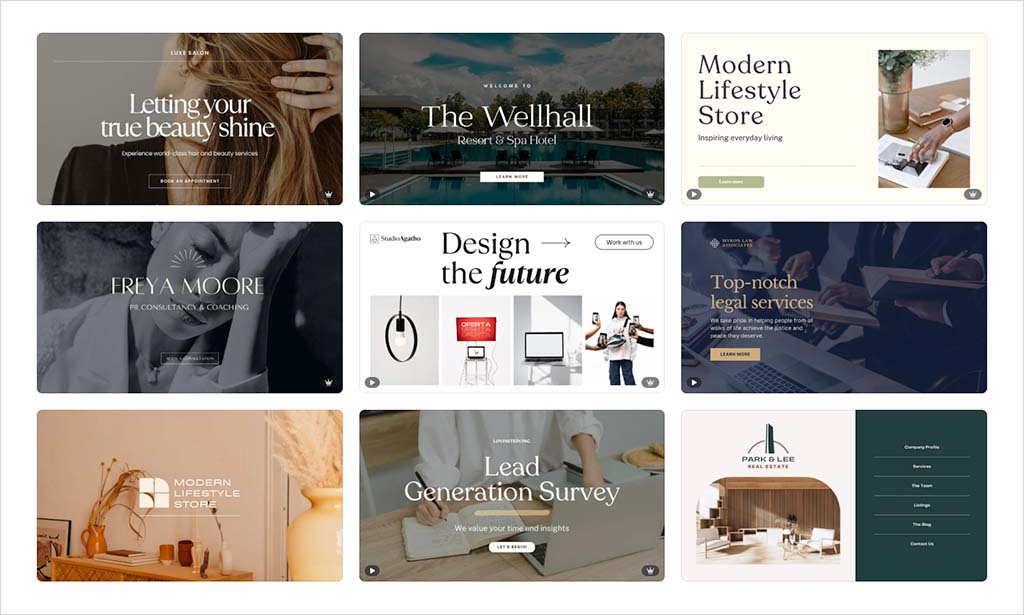
Brand kits
Canva’s ‘brand kit’ feature lets you upload a logo and your own fonts, and define a palette containing your brand colors.

This helps you ensure that anything you produce in Canva remains aligned with your brand’s visual identity.
While you can only create one brand kit on the free plan, on the ‘Canva Pro’ plan you can work with up to 5 of them. Furthermore, ‘Canva Pro’ gives you extra tools for maintaining control over your brand, including element locking and sign-off features.
Full access to Canva’s ‘Magic Studio’ features
Canva Pro users get full access to Canva’s ‘Magic Studio’ — a growing arsenal of 20+ different AI-powered design tools.
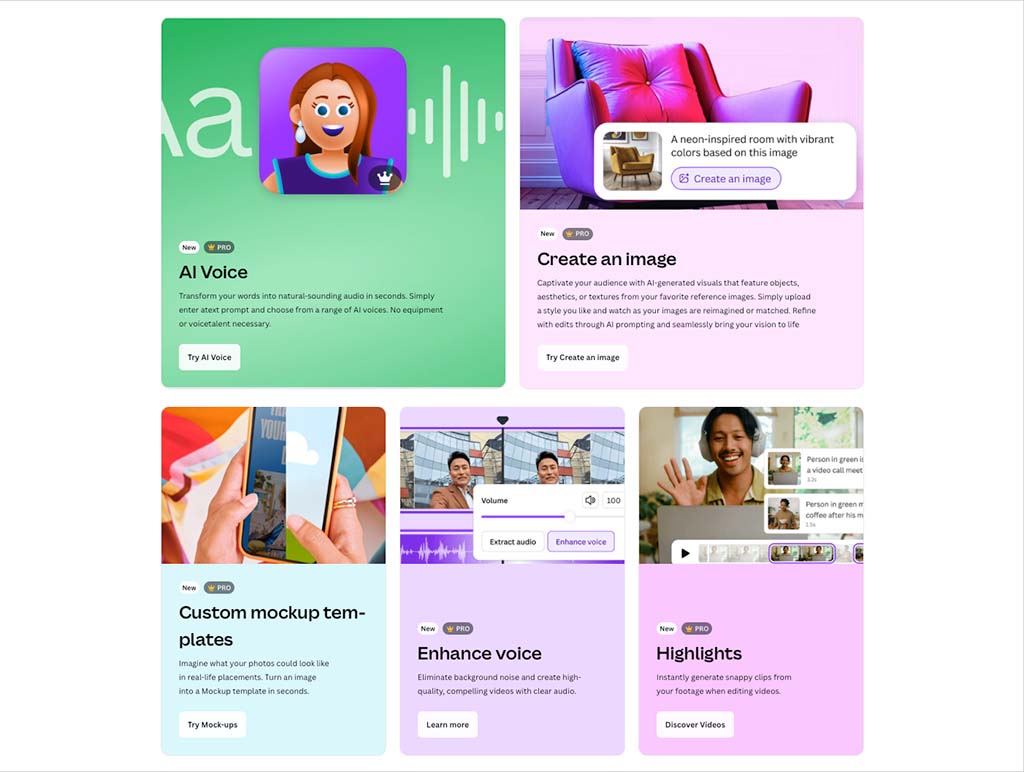
Magic Studio includes image generation tools, a translation tool, and a range of useful editing features that let you use Canva’s built-in AI to expand, animate and transform your designs.
The Magic resize tool
A particularly useful feature only available to ‘Canva Pro’ users is the ‘Magic Resize’ tool — this lets you repurpose existing designs for different platforms really easily.
It lets you open an existing design, and then automatically reformat it to suit different social media channels.
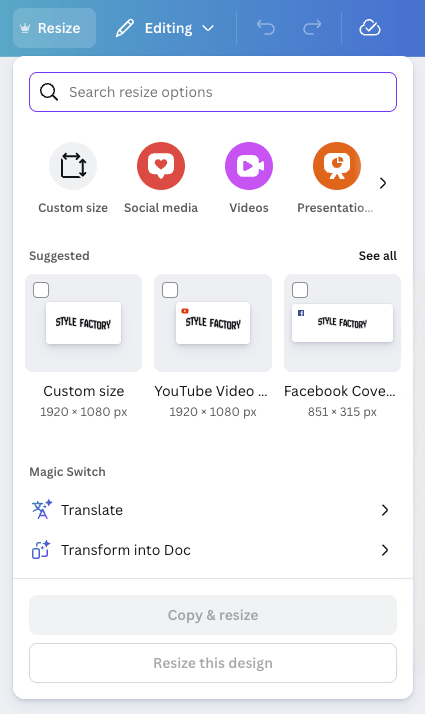
For example, you could use this to turn a blog post banner into a Facebook post image and a YouTube video thumbnail just by clicking a button (helpfully, the feature lets you output all your repurposed assets in one go).
Take a look at the video below to get a sense of how this works in practice.
Background remover
On the ‘Canva Pro’ plan, you get access to a background removal tool. This makes it very easy to take a headshot with a background and put whatever you like behind it.

If you’re a YouTube creator, you’ll find this particularly handy for creating brash video thumbnails of yourself looking shocked at the content of your own videos…
Transparent background downloads
A related feature that’s available on ‘Canva Pro’ but not on the free version is the option to download your designs with a transparent background.
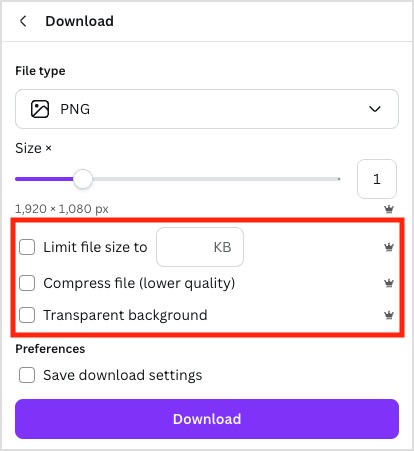
This is particularly useful if you’re designing logos that you want to superimpose onto different assets — the transparent background means that your design can be applied neatly and easily over something else.
(The Pro version also lets you compress your work to a specified file size.)
Custom template design
While the free version of Canva only lets you work with pre-designed Canva templates, ‘Canva Pro’ lets you create your own ones.
This means that you can create on-brand, standardized templates for your team to use.
Storage and folders
With the free version of Canva, you get 5GB of storage; this will be eaten up quickly by any large multimedia files that you add to the platform.
‘Canva Pro’ gives you 20 times that amount — a 100GB storage limit applies. This limit should be fine for most — the only users who might not be entirely satisfied with it are those who edit a very large amount of video content.
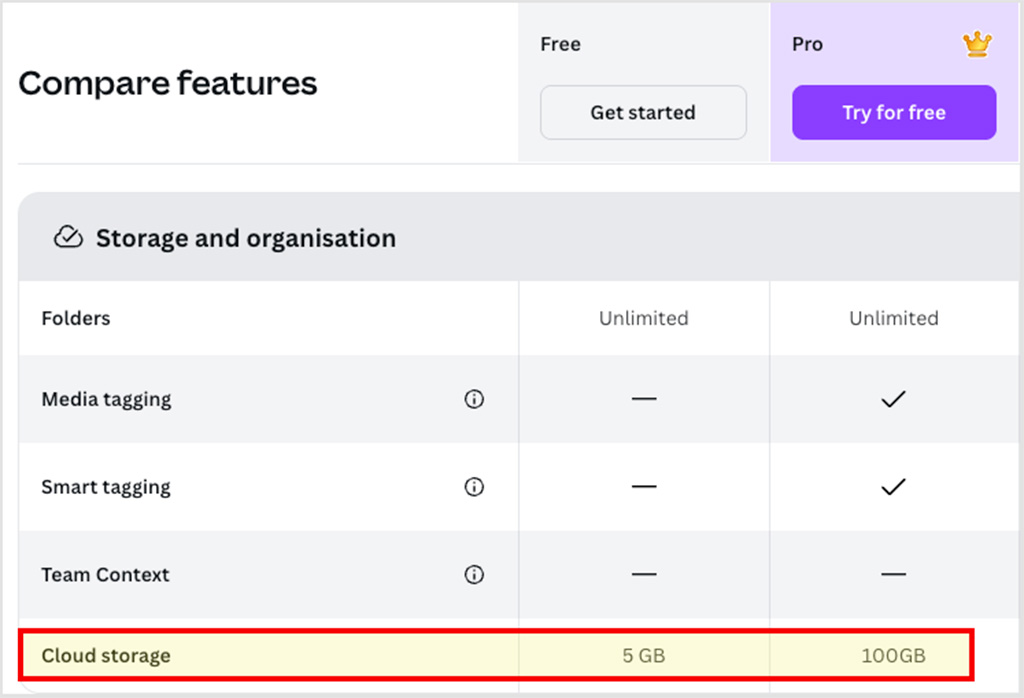
Customer support
On ‘Canva Pro,’ you get access to full support services (via a contact form / email).
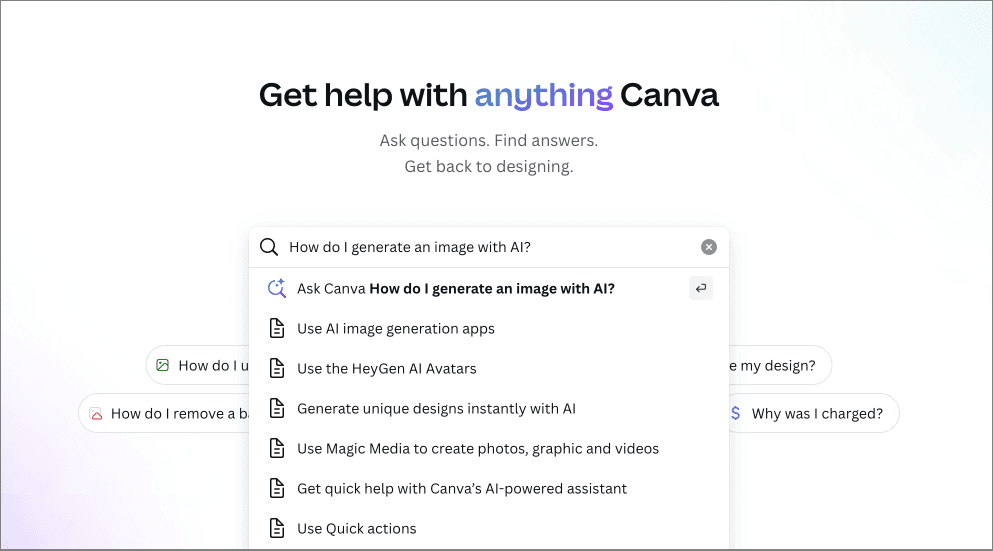
This is not the case with the free version of Canva — if you’re on this plan, you’ll largely have to make do with Canva’s help portal and AI chatbots.
(Help with ‘select issues’ is provided to free plan users, however — presumably serious ones, like issues with account access.)
Canva Business — $20 per user per month or $200 per user per year
The ‘Canva Pro’ plan will usually satisfy the needs of ‘solopreneurs’ perfectly well. However, it’s not great for organizations that need multi-user access.
This is where ‘Canva Business’ — formerly ‘Canva Teams’ — comes in.
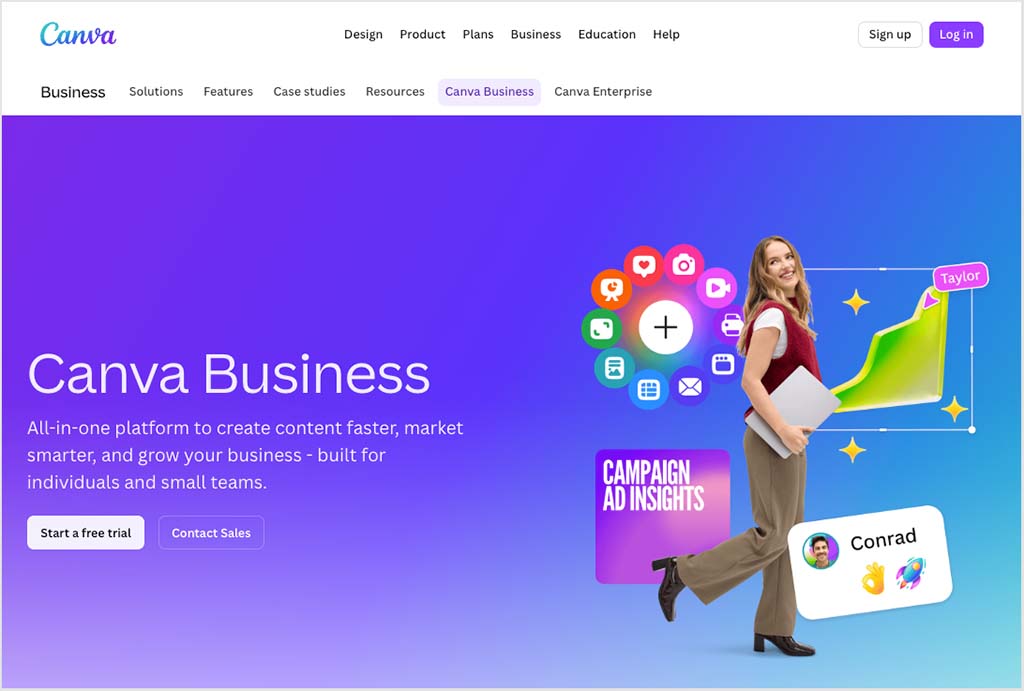
This plan costs $20 per user per month, or $200 per user per year (if paying annually).
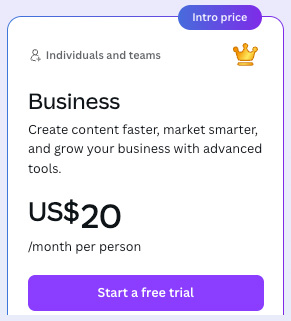
So, what do you actually get on a ‘Canva Business’ plan that isn’t available on the free or ‘Pro’ versions?
Let’s find out.
Workflow management
If you want to run a managed approvals process on designs, you can use the ‘Canva Business’ plan’s workflow management features to do this.
These tools give you a huge amount of control over collaboration — they let you invite team members to work on projects, assign specific roles, and transfer ownership of designs or brand assets when responsibilities change. They also let you generate activity reports to keep track of how Canva is being used across your organization.
Together, these features make ‘Canva Business’ well suited to larger teams that need oversight of creative workflows and a structured approval process.
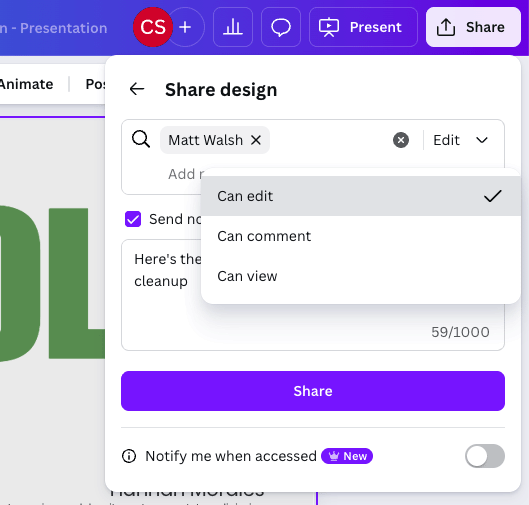
Template locking
The ‘Canva Business’ plan lets you lock down your templates more tightly — this gives you more control over the appearance of your assets and helps you avoid ‘drift’ away from standard brand guidelines.
Team-only links
Another useful feature you get on ‘Canva Business’ but not on ‘Canva Pro’ is the ability to share team-only links. These let you share designs securely within your organization, ensuring that only team members can view or edit your work.
AI admin controls
‘Canva Business’ lets you oversee and manage your team’s access to the many AI design tools available in Canva.
Storage
While the ‘Free’ and ‘Pro’ plans limit you to 5GB and 100TB of storage space respectively, the ‘Canva Business’ plan allocates 500GB of storage to every member of your team, making it a more suitable and scalable option for companies that work with a large number of big multimedia files (video, audio, etc.).
Domain report
The ‘Domain Report’ feature in ‘Canva Business’ provides business owners with comprehensive analytics on design activities.
It tracks the number and types of designs created, edited, and shared by team members, allowing owners to monitor user engagement and identify both power users and those who may need additional support. This feature ensures efficient and productive use of Canva across the team.
More brand kits
While the ‘Canva Pro’ plan lets you create up to 5 brand kits, the Canva Business plan expands this to 100. It also lets you link folders to brand kits, making it easier to organize and access the right assets for each project.
Print discounts
Canva lets you order printed versions of your designs directly through its built-in printing service — available products include business cards, flyers, posters, stickers, tote bags and more. With the ‘Canva Business plan,’ you get a 10% discount on all print orders.
Canva Enterprise — custom pricing
‘Canva Enterprise’ is a relatively new offering from Canva, aimed at larger organizations.
Pricing for ‘Canva Enterprise’ is customized to the specific needs and requirements of your organization — you’ll need to contact Canva to negotiate a price for it.
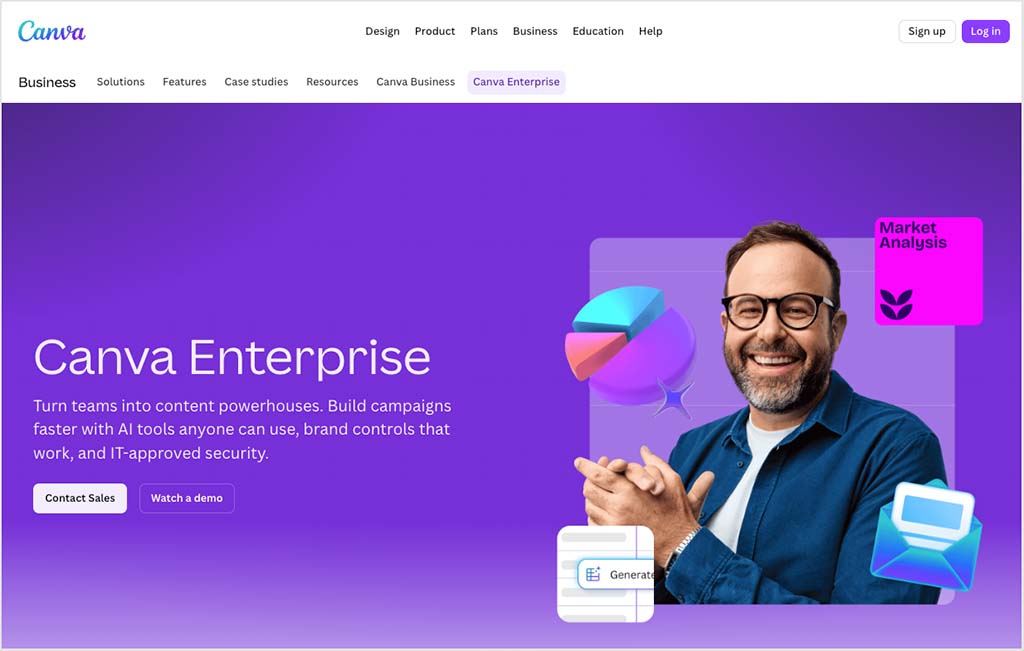
Unlike the other Canva plans, ‘Canva Enterprise’ lets you create multiple teams across one organization; it also lets admins control element editing and design permissions more tightly.
Some of the other key features only available to ‘Canva Enterprise’ users are as follows…
IP Indemnity content control
The IP Indemnity content control feature in Canva for Enterprise offers businesses protection against intellectual property (IP) infringement claims. It ensures that any content created or used within Canva complies with legal standards — reducing the risk of legal disputes over IP rights.
Note: to access this feature, you’ll need to have a minimum of 100 users on your ‘Canva Enterprise’ account.
Single Sign-On (SSO)
Single sign-on (SSO) lets a user use one set of login credentials to access multiple applications, making username and password management easier.
On a ‘Canva Enterprise’ plan, you can include Canva in the apps you use SSO for.
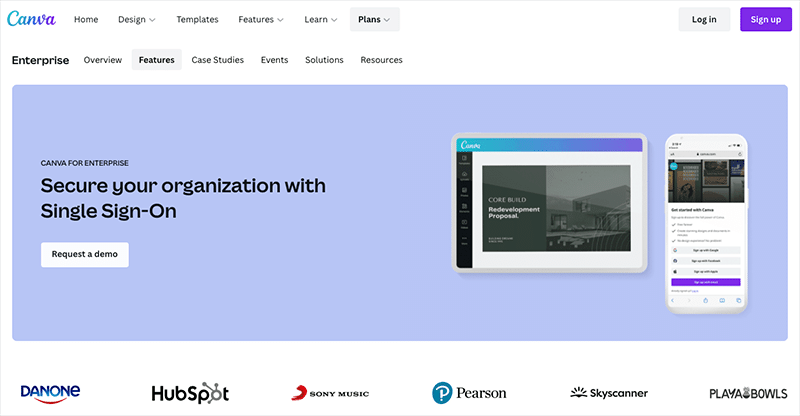
Dedicated support and training
‘Canva Enterprise’ users benefit from dedicated support and training resources. These include a dedicated account manager, priority support, and access to training sessions tailored to your team’s needs
More storage
The ‘Canva Enterprise’ plan gives each user 1TB of cloud storage — double the 500GB provided on ‘Canva Business’ and ten times the 100GB available on ‘Canva Pro.’
Even more brand kits
The ‘Canva Enterprise’ plan takes brand management significantly further than the other plans, letting you create and use up to 1,000 brand kits. This makes it ideal for large organizations or agencies handling multiple brand portfolios.
Canva for educational and not-for-profit organizations — what are the costs?
In addition to the plans that are aimed at businesses, Canva provides several plans that are designed for the education and charity sectors.
‘Canva for Education‘ is free for ‘K-12’ teachers and students (with ‘K-12’ referring to US education levels that stretch from Kindergarten to 12th grade).
(For the record, Canva contains around 80,000 templates that are specifically designed for educational purposes.)
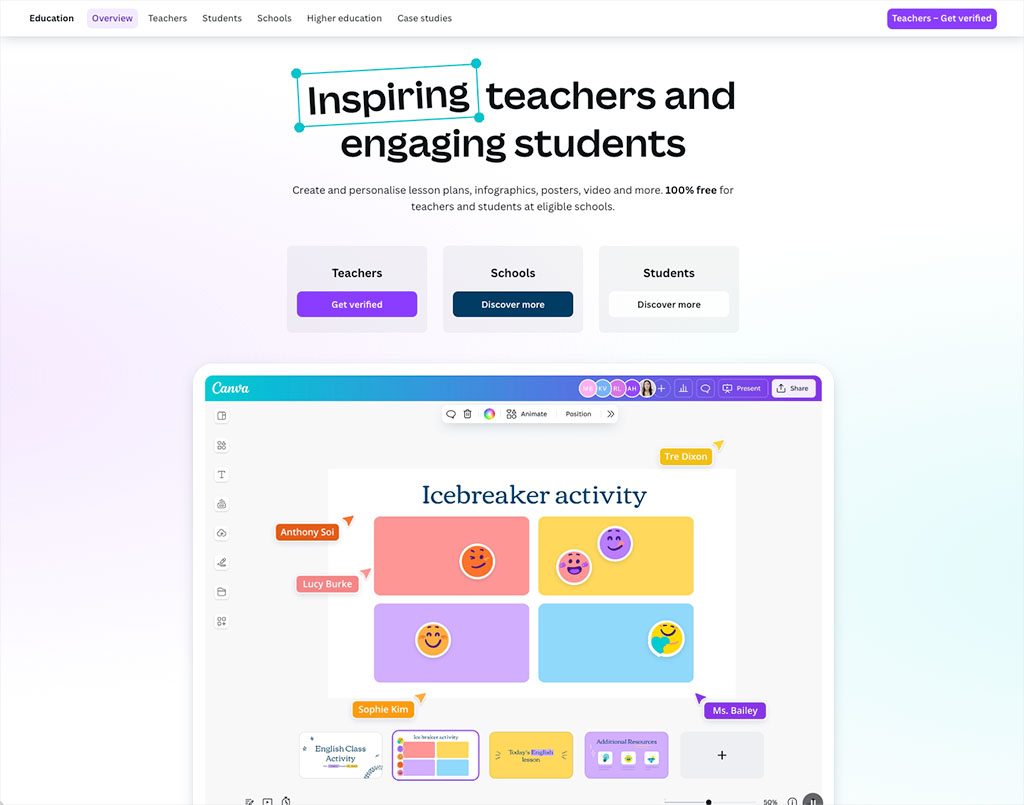
As its name suggests, ‘Canva for Nonprofits‘ is a version of the platform that’s free for those working in the charity sector. It can be used for free by up to 50 people (depending on the type of organization), with extra seats available at a 50% discount.
An application process is involved before you can use Canva for Nonprofits, during which Canva’s team will verify your eligibility for the plan.
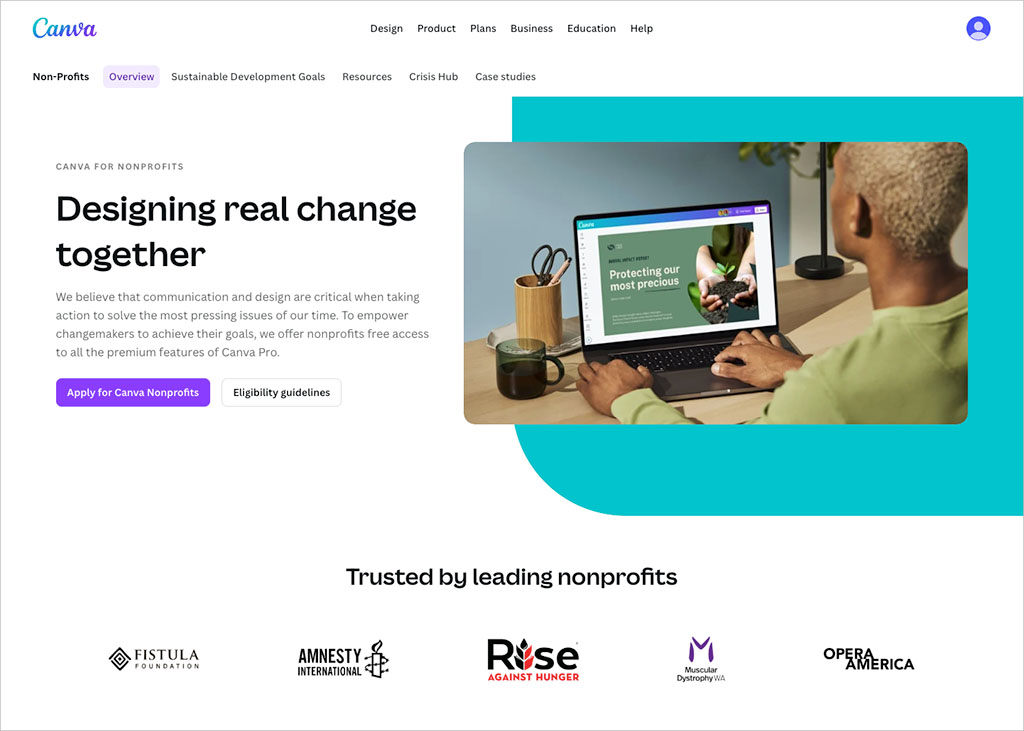
Recently, Canva also launched a plan aimed at universities and higher education institutions. This is called ‘Canva Campus.’
Unlike the ‘Canva for Education’ and ‘Canva for Nonprofits’ plans mentioned above however, ‘Canva Campus’ is not entirely free to use, however — institutions need to pay for seats (pricing for these is negotiable).

So which version of the Canva app is right for me?
Hopefully this Canva pricing guide has helped you identify the key differences between the various plans on offer and helped you understand whether or not a free or a paid-for plan is best for you.
But to sum up, here’s my take on which plan is best suited for different types of users:
If you don’t have any budget to play with at all, or you’re curious about what Canva can do, try ‘Canva Free.’
If you work alone and want to access all the Canva features, or need a very cheap source of royalty-free images and videos, try ‘Canva Pro.’
If you need to provide your team members with access to Canva, and need advanced workflow management, and tighter controls over branding, try ‘Canva Business.’
If you’re working in a large organization and need advanced security, SSO, IP indemnity, or advanced permissions management, consider Canva Enterprise.
If you’re an educational user or non-profit user, consider using one of the dedicated Canva plans aimed specifically at your type of institution:
- Canva for Education (primary schools)
- Canva Campus (higher education institutions)
- Canva for Nonprofits
Got any questions? Leave a comment!
Alternatives to Canva
When it comes to browser-based apps, key alternatives include Visme, Adobe Express (formerly Adobe Spark), Kittl and VistaCreate (formerly Crello).
These are similarly affordable graphic design tools that let non-professional designers create visual material (note: we have a Visme vs Canva comparison here, a VistaCreate vs Canva shootout here and an Adobe Express vs Canva comparison here).
Desktop applications like Adobe Photoshop, Illustrator and Premiere (and other graphic design software you get in an Adobe Creative Cloud subscription) can also serve as alternatives to Canva. But they’re a bit different in nature — while Canva offers you a built-in library of royalty-free photos, graphics and videos, you usually have to source assets ‘outside’ of the Adobe apps.
(You can learn more about the differences between Adobe Photoshop and Canva in our in-depth comparison of the two products.)
Understanding the pros and cons of Canva
Although we generally love Canva and view it as a really user-friendly solution for creating graphics, it’s not going to be right for everyone: there are quite a lot of pros and cons to consider when deciding whether or not to use it.
So, to get a really in-depth appraisal of all the features Canva provides, do check out our detailed Canva review. You might also find our What is Canva? article and our Canva Pro vs Free comparison guide helpful.
Canva pricing — FAQ
Can I use Canva for free?
Yes. A cut-down version of the tool is available that can be used indefinitely, and free plans are available to students and not-for-profit organisations (subject to eligibility criteria). A 30-day free trial of the ‘Pro’ version is also available.
Is paying for Canva worth it?
Although you can do a lot with the free version of Canva, the design tools you get on a paid-for plan let you create much more sophisticated visuals. The strongest arguments for upgrading to a premium plan are probably the amount of free stock images, videos and audio files you get; the export options; the brand kit features; and the background removal tools.
How much does Canva cost each month?
It depends on whether you are using ‘Canva Pro’ or ‘Canva Business’. Canva Pro costs $15 per month, and the pricing for Canva Business costs $20 per user per month.
Are there any discounts available for Canva?
At time of writing, Canva is offering 50% off its Canva Pro or Canva Business plans to new customers.
Update details
This article was updated on January 7, 2026. The following key updates were made:
- A new, ‘quick answer’ section was added to the article.
- The plan names for Canva’s pricing tiers were updated (to reflect changes to its educational offering).
- Product screenshots were updated.
Comments (6)
Thank you so much for an enlightening article. So informative! There is, however, one question that has not been covered – namely the cost of a Canva domain! Could you please expand on that? I noticed the 3 different categories – but what would it cost if you want to use only your own name? And – is this a monthly, or annual or a once-off fee? Thanking you in advance for your response. Jeannie Burke
Hi Jeannie. As long as you are on a Canva Pro, Canva for Teams, or Canva for Education plan, you can connect your own domain name to a Canva website for free. Just bear in mind that you can only connect up to 5 existing domains at a time. You can find more information on using your own domain name with a Canva website here: https://www.canva.com/help/publishing-websites-own-domains/
If you prefer to buy a domain from Canva directly, this involves a single annual fee of around $18.99 per domain per year for a .com address. Canva will send you an email notification one week before a purchased domain is set to renew. Further info here: https://www.canva.com/help/publishing-websites-purchasing-domains/
Hope that helps!
I want to create a logo for our new charter boat business and plan to use 4 of the premium features (elements, etc). Can I pay for the single use, or do I have to upgrade to pro in order to have access to them without the watermark? I won’t be creating anything other than that one logo, so I feel like the Pro version is more than I need at this time. Also, if I don’t upgrade, can I save/download in different formats and be able to use commercially?
Hi Wendy, I’d suggest that in this case you simply go for a monthly subscription and use the tool’s premium features for as long as you need them — you can cancel your subscription at any point (I suspect you might end up holding onto to it though as you’d be surprised at how useful the tool comes in not just for logo design but for other aspect of business comms). The other thing worth considering is that Canva lets you use all features of the premium version for a trial period — there’s a link to a 45-day trial here.
To answer your other queries, the save/download options are more limited on the free version so you would need to make sure that you had downloaded everything in the right format before cancelling a pro subscription. And as for image usage rights, I’d suggest checking this information to get a good understanding of what you can and can’t do with stock imagery used in Canva.
Is Canva Pro an additional $7 per person (over the 5 people included) or $7 just to simply go over the 5?
Hey Kris, once you go over the 5-person limit it’s an additional $7 per person. Hope this helps!